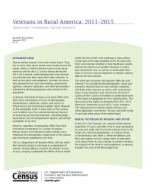Veterans in Rural America: 2011–2015
Veterans in Rural America: 2011–2015
Introduction
Twenty million veterans live in the United States. They live in every state and in nearly every county across the nation. About 5 million veterans lived in areas designated as rural by the U.S. Census Bureau during the 2011–2015 period. Understanding who rural veterans are and what sets them apart from other veterans, as well as from their rural neighbors, provides the necessary perspective for rural communities, government agencies, veterans’ advocates, and other policymakers interested in directing programs and services to this population.
In general, individuals living in rural areas differ from their urban counterparts in terms of demographic characteristics, social ties, culture, and access to infrastructure and institutional support. Much depends on the geography itself. In some parts of the country, rural residents may face substantial physical barriers to accessing services and amenities, including longer travel times, lack of transportation options, and limited availability of services.
Veterans, regardless of geography, differ from their nonveteran counterparts in a variety of aspects. Military history and enlistment policy changes have influenced the demographic composition of the veteran and nonveteran populations over time.
The U.S. Department of Veterans Affairs (VA) has identified veterans living in rural areas as a population of interest. To help address concerns of veterans’ access to care, Congress established the Office of Rural Health within the VA in 2007. One challenge in these efforts is that most of the data available to the VA come only from rural veterans enrolled in their healthcare system, and not all veterans are enrolled. However, to anticipate demand for care, as well as to understand what types of services may be requested or utilized, requires data on all rural veterans.
This brief aims to answer the question “Who are rural veterans?” by considering the demographic, social, and economic characteristics of rural veterans compared with both urban veterans as well as with rural nonveterans. It also examines rural veterans by the level of rurality of their county of residence to understand some of the impact of geography on their characteristics. The data used in this report are primarily from 2011–2015 American Community Survey (ACS), 5-year estimates. This report presents statistics about veterans and, where applicable, nonveterans 18 years and older living in rural and urban areas of the United States.
Additional Tables
Table 1. Selected Characteristics of Veterans by State and Urban/Rural Residence
Table 2. Poverty Statistics for Veterans, by State and Urban/Rural Residence
Table 3. Employment Characteristics for Working-Age Veterans, by State and Urban/Rural Residence
Others in Series
Publication
Publication
Publication





